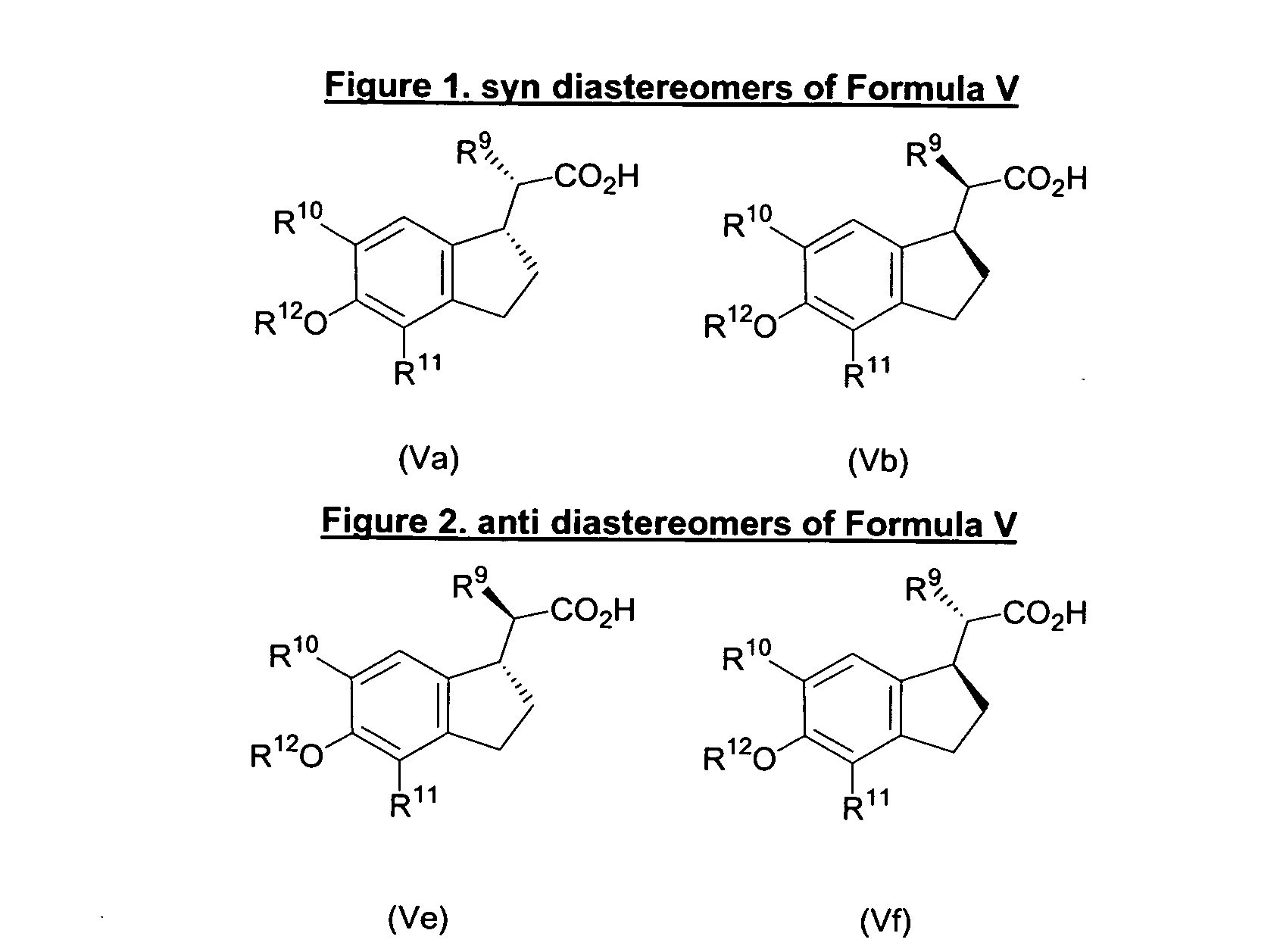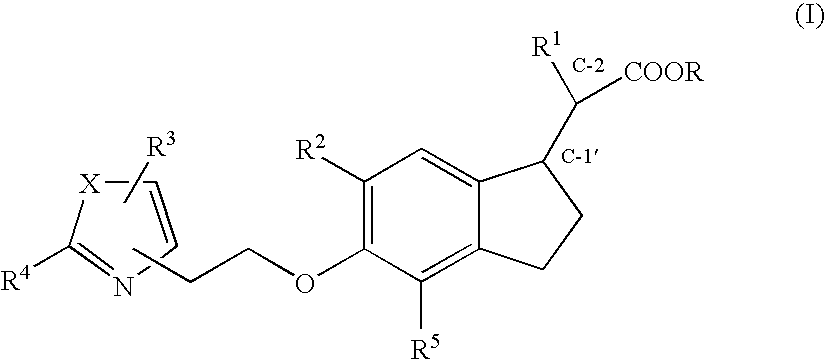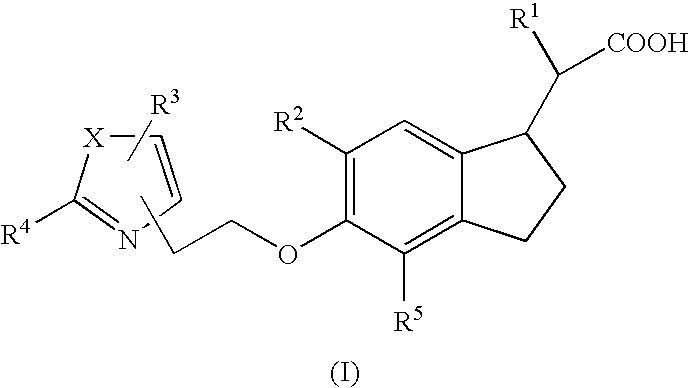Indane acetic acid derivatives and their use as pharmaceutical agents, intermediates, and method of preparation
a technology of acetic acid derivatives and indane, which is applied in the field of indane acetic acid derivatives, can solve the problems of fasting hyperglycemia, deterioration of glucose homeostasis, and subsequent development of overt diabetes
- Summary
- Abstract
- Description
- Claims
- Application Information
AI Technical Summary
Problems solved by technology
Method used
Image
Examples
specific examples
HPLC-electrospray mass spectra (HPLC ES-MS) were obtained using a Hewlett-Packard 1100 HPLC equipped with a quaternary pump, a variable wavelength detector, a YMC Pro C18 2.0 mm×23 mm column, and a Finnigan LCQ ion trap mass spectrometer with electrospray ionization. Gradient elution from 90% A to 95% B over 4 minutes was used on the HPLC. Buffer A was 98% water, 2% Acetonitrile, and 0.02% TFA, and Buffer B was 98% Acetonitrile, 2% water, and 0.018% TFA. Spectra were scanned from 140-1200 amu using a variable ion time according to the number of ions in the source.
Proton (1H) nuclear magnetic resonance (NMR) spectra were measured with a General Electric GN-Omega 300 (300 MHz) spectrometer with either Me4Si (δ 0.00) or residual protonated solvent (CHCl3 δ 7.26; MeOH δ 3.30; DMSO δ 2.49) as standard. Carbon (13C) NMR spectra were measured with a General Electric GN-Omega 300 (75 MHz) spectrometer with solvent (CDCl3 δ 77.0; d3-MeOD; δ 49.0; d6-DMSO δ 39.5) as standard.
Chiral separ...
example 1
Preparation of methyl 2-(6-methoxy-1H-inden-3-yl)butanoate
An oven dried 5-L four-necked round-bottomed flask was fitted with a thermometer, a condenser, an addition funnel, and a mechanical stirrer. Under Ar protection, a suspension of 5-methoxy-1-indanone (80.0 g, 494 mmol), Zn powder (Lancaster, 56.2 g, 865 mmol) in 2 L anhydrous THF was stirred at 60° C. (internal temperature), while a solution of methyl bromobutyrate (134.1 g, 741 mmol) in 400 mL anhydrous THF was added slowly through an addition funnel. After completion of the addition, the reaction mixture was stirred at 60° C. (internal temperature) for 1 hour. The reaction was followed by TLC analysis of aliquots following 1N aqueous HCl work-up. After the reaction was completed, it was cooled in an ice-water bath followed by slow addition of 3 L of 1N HCl solution. The pot temperature was kept below 20° C. The mixture was then extracted with 1 L EtOAc. The organic layer was washed with water until pH 6.0-7.0, then saturat...
example 2a
Preparation of 2-(6-methoxy-1H-inden-3-yl) Butanoic Acid
To a solution of the ester prepared in Example 1 (14.0 g, 58.9 mmol) in 140 mL MeOH, was added a solution of KOH (6.4 g, 113.8 mmol) in 5 mL water. The reaction mixture was stirred at 60° C. (pot temperature) for 2 hours. TLC showed 70% conversion. A solution of KOH (3.0 g, 53.6 mmol) in 100 mL water was then slowly added to the pot. After 1 hour, the reaction was completed. After cooling to room temperature, the solvents were removed at a reduced pressure. The residue was dissolved in 500 mL water, and then washed with EtOAc. The aqueous layer was cooled in an ice-water bath, and then acidified with conc. HCl to pH<3.0. The product was extracted into 300 mL CH2Cl2, washed with water (2×100 mL), then dried over Na2SO4. After Na2SO4 was filtered off, the CH2Cl2 solution was stirred with 3.0 g of charcoal for 2 hours. The charcoal was removed by filtration through a pad of Celite®. The title product (12.5 g, 95%) was obtai...
PUM
| Property | Measurement | Unit |
|---|---|---|
| Fraction | aaaaa | aaaaa |
| Time | aaaaa | aaaaa |
| Pressure | aaaaa | aaaaa |
Abstract
Description
Claims
Application Information
 Login to View More
Login to View More - R&D
- Intellectual Property
- Life Sciences
- Materials
- Tech Scout
- Unparalleled Data Quality
- Higher Quality Content
- 60% Fewer Hallucinations
Browse by: Latest US Patents, China's latest patents, Technical Efficacy Thesaurus, Application Domain, Technology Topic, Popular Technical Reports.
© 2025 PatSnap. All rights reserved.Legal|Privacy policy|Modern Slavery Act Transparency Statement|Sitemap|About US| Contact US: help@patsnap.com



